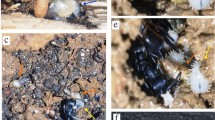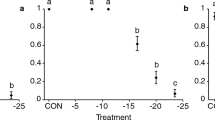Abstract
If generalist insect predators are a selective force contributing to patterns of feeding specialization by insect herbivores, then predators should be deterred from eating allelochemical-fed prey. The attack and feeding behaviors of naive predators (Podisus maculiventris stinkbugs) reared on control caterpillars (Manduca sexta) fed plain diet were compared to experienced predators reared on caterpillars fed tomato allelochemicals. Tomatine-fed prey were found more quickly by both naive and tomatine-experienced predators, and chlorogenic acid-experienced predators were more stimulated to begin searching for prey. However, experienced predators were less likely to attack both chlorogenic acidfed and tomatine-fed caterpillars than were naive predators. These results indicate that allelochemical-fed prey were easier for predators to locate, but allelochemical-containing prey often deterred predation by experienced predtors.
Similar content being viewed by others
References
Aldrich, J. R., Kochansky, J. P., and Sexton, J. D. (1984). Chemical attraction of the eastern yellowjacket,Vespula maculifrons (Hymenoptera: Vespidae).Experientia 41: 420–422.
Barbosa, P. (1988). Natural enemies and herbivore-plant interactions: Influence of plant allelochemicals and host specificity. In Barbosa, P., and Letourneau, D. K. (eds.),Novel Aspects of Insect Plant-Interactions, John Wiley & Sons, New York, pp. 201–229.
Barbosa, P., Saunders, J. A., Kemper, J., Trumbule, R., Olechno, J., and Martinat, P. (1986). Plant allelochemicals and insect parasitoids: Effects of nicotine onCotesia congregata (Say) (Hymenoptera: Ichneumonidae).J. Chem. Ecol. 12: 1319–1327.
Barbosa, P., Gross, P., and Kemper J. (1991). Influence of plant allelochemicals on the tobacco hornworm and its parasitoidCotesia congregata.Ecology 72: 1567–1575.
Bell, R. A., and Joachim F. G. (1976). Techniques for rearing laboratory colonies of tobacco hornworms and pink bollworms.Ann. Entomol. Soc. Am. 69: 365–373.
Berenbaum, M. R., and Miliczky E. (1984). Mantids and milkweed bugs: Efficacy of aposematic coloration against invertebrate predators.Am. Midl. Nat. 111: 64–68.
Bernays, E. A. (1988). Host specificity in phytophagous insects: Selection pressure from generalist predators.Entomol. Exp. Appl. 49: 131–140.
Bernays, E. A., and Cornelius, M. L. (1989). Generalist caterpillar prey are more palatable than specialists for the generalist predatorIridomyrmex humilis.Oecologia 79: 427–430.
Bernays, E. A., and Graham, M. (1988). On the evolution of host specificity in phytophagous arthropods.Ecology 69: 886–892.
Bloem, K. A., Kelley, K. C., and Duffey, S. S. (1989). Differential effects of tomatine and its alleviations by cholesterol on larval growth and efficiency of food utilization inHeliothis zea andSpodoptera exigua.J. Chem. Ecol. 15: 387–397.
Bowers, M. D. (1992). The evolution of unpalatability and the cost of chemical defense in insects. In Roitberg, B. D., and Isman, M. B. (eds.),Insect Chemical Ecology, Chapman & Hall, New York, pp. 216–243.
Bowers, M. D. (1993). Aposematic caterpillars: Life-styles of the warningly colored and unpalatable. In Stamp, N. E., and Casey, T. M. (eds.),Caterpillars: Ecological and Evolutionary Constraints on Foraging, Chapman & Hall, New York, pp. 331–371.
Brown, K. S. (1984). Adult-obtained pyrrolizidine alkaloids defend Ithiomiine butterflies against a spider predator.Nature 309: 707–709.
Campbell, B. C., and Duffey, S. S. (1979). Tomatine and parasitic wasps: Potential incompatibility of plant antibiosis with biological control.Science 205: 700–702.
Campbell, B. C., and Duffey, S. S. (1981). Alleviation of tomatine induced toxicity to the parasitoid,Hyposoter exigua, by phytosterols in the diet of the host,Heliothis zea.J. Chem. Ecol. 7: 927–941.
Dicke, M., Sabelis, M. W., Takabayashi, J., Bruin, J., and Posthumus, M. A. (1990). Plant strategies of manipulating predator-prey interactions through allelochemicals: Prospects for applications in pest control.J. Chem. Ecol. 16: 3091–3118.
Duffey, S. S. (1980). Sequestration of plant natural products by insects.Annu. Rev. Entomol. 25: 447–477.
Duffey, S. S., Bloem, K. A., and Campbell, B. C. (1986). Consequences of sequestration of plant natural products in plant-insect-parasitoid interactions. In Boethal, D. J., and Eikenbary, R. D. (eds.),Interactions of Plant Resistance and Parasitoids and Predators of Insects, Halsted Press, New York, pp. 31–60.
El-Heneidy, A. H., Barbosa, P., and Gross, P. (1988). Influence of dietary nicotine on the fall armyworm,Spodoptera frugiperda, and its parasitoid, the ichneumonid wasp,Hyposoter annulipes.Entomol. Exp. Appl. 46: 227–232.
Elliger, C. A., Wong, Y., Chan, B. G., and Waiss, A. C. Jr. (1981). Growth inhibitors in tomato (Lycopersicon) to tomato fruitworm (Heliothis zea).J. Chem. Ecol. 7: 753–758.
Evans, W. G. (1982).Oscillatoria sp (Cyanthophyta) mat metabolites implicated in habitat selection inBembidion obsusidens (Coleoptera: Carabidae).J. Chem. Ecol. 8: 671–678.
Gelperin, A. (1968). Feeding behavior of the praying mantis: A learned modification.Nature 219: 399–400.
Greany, P. D., and Hagen, K. S. (1981). Prey selection. In Nordlund, D. A., Jones, R. L., and Lewis, W. J. (eds.),Semiochemicals: Their Role in Pest Control, John Wiley & Sons, New York, pp. 121–135.
Griffith, J. Q., Krewson, C. F., and Naghski, J. (1955).Rutin and Related Flavonoids, Mack, Easton, PA.
Horan, H. N. (1955) The effect of prey species and prey diet on an insect predator, master's thesis, Binghamton University, State University of New York, Binghamton.
Isman, M. B., and Duffey, S. S. (1982a). Toxicity of tomato phenolic compounds to the fruitworm,Heliothis zea.Entomol. Exp. Appl. 31: 370–376.
Isman, M. B., and Duffey, S. S. (1982b). Phenolic compounds in foliage of commercial tomato cultivars as growth inhibitors to the fruitworm,Heliothis zea.J. Am. Soc. Hort. Sci. 107: 167–170.
Isman, M. B., and Duffey, S. S. (1983). Pharmacokinetics of chlorogenic acid and rutin in larvae ofHeliothis zea.J. Insect Physiol. 29: 295–300.
Maddrell, S. H. P., and Gardiner, B. O. C. (1976) Excretion of alkaloids by Malpighian tubules of insects.J. Exp. Biol. 64: 267–281.
Malcolm, S. B. (1986). Aposematism in a soft-bodied insect: A case for kin selection.Behav. Ecol. Sociobiol. 18: 387–393.
Malcolm, S. B. (1989). Disruption of web structure and predatory behavior of a spider by plant-derived chemical defenses of an aposematic aphid.J. Chem. Ecol. 15: 1699–1716.
Malcolm, S. B. (1992). Prey defense and predator foraging. In Crawley, M. J. (ed.),Natural Enemies: The Population Biology of Predators, Parasites, and Diseases, Blackwell Scientific, Oxford, pp. 458–475.
McClain, D. K. (1979). Terrestrial trail following by three species of predatory stinkbugs.Fla. Entomol. 62: 152–154.
McPherson, J. E. (1980). A list of prey species ofPodisus maculiventris (Hemiptera: Pentatomidae).Gt. Lakes Entomol. 13: 17–24.
Mukerji, M. K., and LeRoux, E. J. (1965). Laboratory rearing of a Quebec strain of the pentatomid predator,Podisus maculiventris (Say) (Hemiptera: Pentatomidae).Phytoprotection 46: 40–60.
National Climatic Center (1979). Comparative climatic data for the United States through 1978. Natl. Oceanic Atmos. Adm., Asheville, NC.
Paradise, C. J., and Stamp, N. E. (1990). Variable quantities of toxic prey cause different degrees of compensatory and inhibitory responses by juvenile praying mantids.Entomol. Exp. Appl. 55: 213–222.
Paradise, C. J., and Stamp, N. E. (1991). Prey recognition time of praying mantids and subsequent survivorship of unpalatable prey.J. Insect Behav. 4: 265–273.
Paradise, C. J., and Stamp, N. E. (1993). Episodes of unpalatable prey reduce consumption and growth of juvenile praying mantids.J. Insect Behav. 6: 155–166.
Reid, C. D., and Lampman, R. L. (1989). Olfactory response ofOrius insidiosus (Hemiptera: Anthocoridae) to volatiles of corn silks.J. Chem. Ecol. 15: 1109–1115.
Schreiber, K. (1968). Steroid alkaloids: The solanum group. In Manskel, R. H. F. (ed.),The Alkaloids: Chemistry and Physiology, Vol. 10, Academic Press, New York, pp. 1–192.
Self, L. S., Guthrie, F. E., and Hodgson, E. (1964). Adaptation of tobacco hornworms to the ingestion of nicotine.J. Insect Physiol. 10: 907–914.
Slansky, F. (1993). Nutritional ecology: The fundamental quest for nutrients. In Stamp, N. E., and Casey, T. M. (eds.),Caterpillars: Ecological and Evolutionary Constraints on Foraging, Chapman & Hall, New York, pp. 29–91.
Sondheimer, E. (1964). Chlorogenic acid and related depsides.Botan. Rev. 30: 664–667.
Stamp, N. E. (1990). Growth versus molting time of caterpillars as a function of temperature, nutrient concentration and the phenolic rutin.Oecologia 82: 107–113.
Stamp, N. E. (1992). Relative susceptibility to predation of two species of caterpillar on plantain.Oecologia 92: 124–129.
Stamp, N. E., and Yang, Y. (1996). Response of insect herbivores to multiple allelochemicals under fluctuating temperatures.Ecology (in press).
Stamp, N. E., Erskine, T., and Paradise, C. J. (1991). The effects of rutin-fed caterpillars on an invertebrate predator depend on temperature.Oecologia 88: 289–295.
Stamp, N. E., Temple, M. P., Traugott, M. S., and Wilkens, R. T. (1994). Temperature-allelochemical effects on performance ofManduca sexta caterpillars.Entomol. Exp. Appl. 73: 199–210.
Thurston, R., and Fox, P. M. (1972). Inhibition by nicotine of emergence ofApanteles congregatus from its host, the tobacco hornworm.Ann. Entomol. Soc. Am. 65: 547–550.
Traugott, M. S. (1994). Effects of tomato allelochemicals on growth, consumption and behavior of an insect predator, Master's thesis, Binghamton University, State University of New York, Binghamton.
Vaillant, J., and Derridj, S. (1992). Statistical analysis of insect preference in two-choice experiments.J. Insect Behav. 5: 773–781.
Vasconellos-Neto, J., and Lewinsohn, T. M. (1984). Discrimination and release of unpalatable butterflies byNephila clavipes a neotropical orb-weaving spider.Ecol. Entomol. 9: 337–344.
Vet, L. E. M., and Dicke, M. (1992). Ecology of infochemical use by natural enemies in a tritrophic context.Annu. Rev. Entomol. 37: 141–172.
Yamamoto, R. T., and Fraenkel, G. S. (1960). The specificity of the tobacco hornworm,Protoparce sexta, to solanaceous plants.Ann. Entomol. Soc. Am. 53: 503–507.
Zhang, Z., and Sanderson, J. P. (1992). Short distance location of spider mite colonies by three predatory mites (Acari: Tetranychidae, Phytoseiidae): Predator responses to prey-and predatorassociated stimuli.Environ. Entomol. 21: 799–807.
Author information
Authors and Affiliations
Rights and permissions
About this article
Cite this article
Traugott, M.S., Stamp, N.E. Effects of chlorogenic acid-and tomatine-fed caterpillars on the behavior of an insect predator. J Insect Behav 9, 461–476 (1996). https://doi.org/10.1007/BF02214023
Revised:
Issue Date:
DOI: https://doi.org/10.1007/BF02214023




